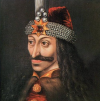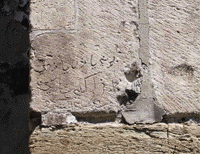

Location: Hunedoara, Hunedoara County Map
Constructed: 1307 by Charles I of Hungary
Open: May- Aug: Tue- Sun: 9am- 6pm, Mon: 9am- 3pm
March- Apr: Tue- Sun: 9am- 5pm, Mon: 9am- 3pm
Sept- Feb: Tue- Sun: 9am- 4pm, Mon: 9am- 3pm
Tel. +40254711423
Hunedoara Castle aka Hunyad Castle is situated near Hunedoara in a Hunedoara county in Romania. This Gothic castle was build in 1307 by Charles I of Hungary. Hunedoara Castle was intended to defend increasingly violent and dangerous region from invading Turkish forces that started to conqueror Byzantium Empire in the south. This citadel was owned once by the Corvin’s family thus giving the castle a second name of Corvin Castle. Hunedoara Castle was used by János Hunyadi as a prison for or Vlad III of Walachia better known as Vlad the Impaler (Dracula) for 7 years. Obviously this fact gave the castle its mystiques and numerous legends that surround it. Today castle is turned into a museum with several wax figures depicting life in the medieval times. Tourists usually spend night at city of Hunedoara, few miles from a citadel.
Hunedoara or Corvin's Castle was build in 1320 by the Anjou family on a ruins of the Roman fortress that already existed here. It was build by the Twelfth Legion or Legio XII Gemina. In fact the hill and surroundings have been home for people since the Stone Age. Iron ore that is easily found in the vicinity of Hunedoara or Corvin Castle made Hunedoara a desired place for humans once they learned how to retrieve it. On October 18, 1409 king Sigismund gave castle to Voicu Corvinus (Hungarian: Hunyadi) for his bravery on the battle field. From that point his descendants became the rulers of the Black Valley along the with the citadel Son of Voicu or Vojk Hunyadi, Janos Hunyadi (John Hunyadi) greatly expanded his Gothic fortress. He was known locally as the "white knight", famous for his victories over Turkish armies that often attacked from the South.
 The
most famous prisoner of
Hunedoara Castle was obviously Vlad III of Walachia (region of
Romania) who spent seven years here. During reign of John Count Vlad
Dracula was an ally of Hunyadi family and Voivode (supreme commander or
a general) of Wallachia. Vlad Dracula was famous for his incredible victories over
Ottoman Turks, who attempted to cross the Danube river from the South
and conquer small Christian nation. Vlad led his troops against the
invaders and defeated them several times. However after the death of
John, Vlad's fate changed. In 1462 he was imprisoned by John's son,
Matthias Corvinus (Matei Corvin).
The
most famous prisoner of
Hunedoara Castle was obviously Vlad III of Walachia (region of
Romania) who spent seven years here. During reign of John Count Vlad
Dracula was an ally of Hunyadi family and Voivode (supreme commander or
a general) of Wallachia. Vlad Dracula was famous for his incredible victories over
Ottoman Turks, who attempted to cross the Danube river from the South
and conquer small Christian nation. Vlad led his troops against the
invaders and defeated them several times. However after the death of
John, Vlad's fate changed. In 1462 he was imprisoned by John's son,
Matthias Corvinus (Matei Corvin).
Local grim legend about him became the base for Dracula in Bram Stoker's 1897 novel. They are two theories how the name Dracula came to be. It might be derivative of a Romanian word "Drăculea" which means "son of the dragon". His father, Vlad II Dracul, was member of the Order of the Dragon created by Emperor Sigismund. However another possible theory is that it comes from a word "Dracul" or simply "the Devil". It would also fit his description. As a ruler of his country he became famous for his cruelty towards his enemies, the Turks, and draconian laws that punished even minor law violation. Some contemporary historians claim that you could easily leave a bag of gold on a major city square and no one would even dare to steal it. Everyone was too afraid of the violent king. The Ottomans who tried to conquer small Christian nation also got a taste of Vlad's cruelty. Legend say that he impaled thousands of captured Turkish soldiers. Thus this gave Vlad his other nickname - Tepes or the Impaler. The same legend claims that he watched his victims slowly die as he dined with bread soaked in enemies' blood. Take that Twilight series and teenage wanna be vampires. He was finally assassinated in December 1476 or January 1477 after he took title of Voivode for the third time. His alleged burial site was opened in the late 20th century. Only animal bones were discovered in an empty coffin. Further increasing the mystery around this controversial man.
In the 17th century Hunedoara Castle was increased under supervision of the Transylvanian prince Gabriel Bethlen. Bethlen wing has more of the Renaissance/ Baroque influence and feels like a private estate rather than part of the formidable fortress. Gabriel also added white tower, gate tower and moved impressive entrance to the citadel to its current position. In the 18th century Huneadora became a possession of the Habsburg family. They didn't care much about castle's rich history or its legends. Instead they simply turned its magnificent Knight Hall, Diet Hall and many other rooms into warehouse for copper ore and copper bricks. From 1724 to 1854 it served this role until a great fire of 1854 didn't destroy many of the wooden beams. Reconstruction of Hunedoara Castle began in 1868 and continued until 1874. Only in 1974 after another restoration did castle became a national museum of Romanian history. In 2009 it was re- opened after another massive reconstruction project.

The well of the Corvin Castle was the main source of water in the time of sieges. Local legend claim that the well was dug by Turkish prisoners who left their graffiti in Arabic. Popular legend claims that it states "you have water, but no soul". It is not entirely correct translation. In fact it states: "he who wrote this inscription is Hasan, who lives as slave at the giaours, in the fortress near the church".
As you walk around Hunedoara Castle you might notice the crest of the Corvin Family. It depicts a raven with a gold rick in its beak. One of the more popular legends that explains its origin states that the owner of the citadel John Hunyadi was the illegitimate son of King Sigismund of Luxembourg who had a love affair with his mother Elisabeth Morzsinay. Subsequently the king forced here to marry one of his nobles Vojk (Voicu) Corby to save the child from stigma of being born outside of wedlock. However as a sign of recognition of his child Sigismund presented his lover with a golden ring as a present to his unborn son. Elisabeth ring was stolen by a raven what flew away. It is said that when John Hunyadi grew up he found the raven, killed him and returned the golden ring of his father. To commemorate this even John adopted a name Corvin (Raven in Latin) or Corvinus.